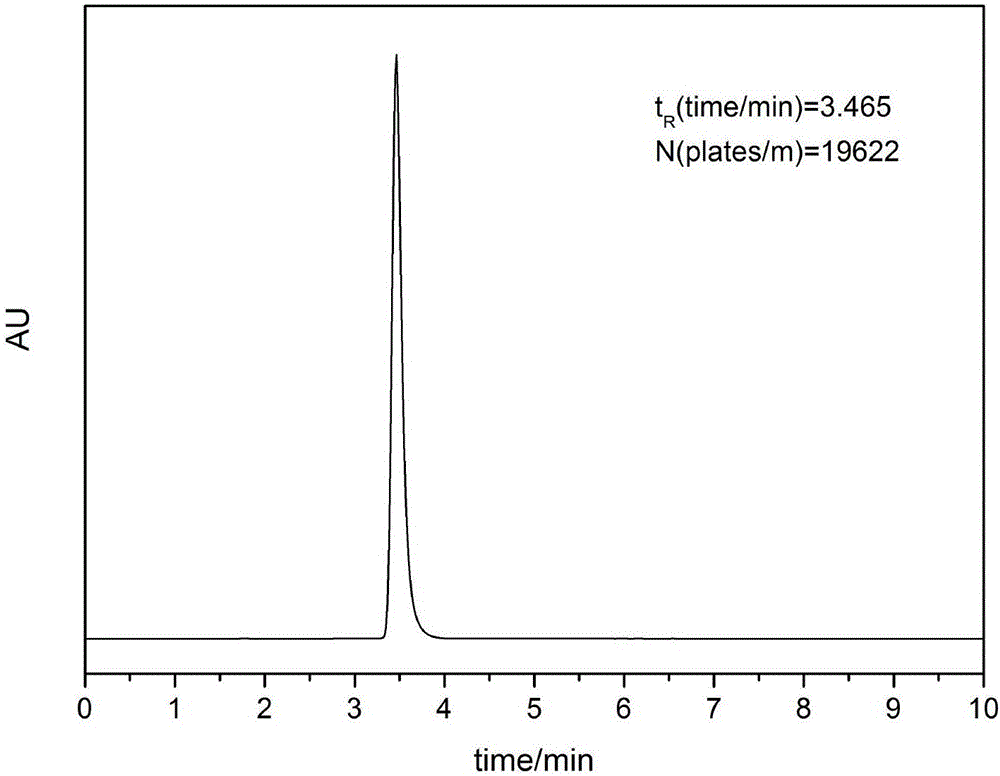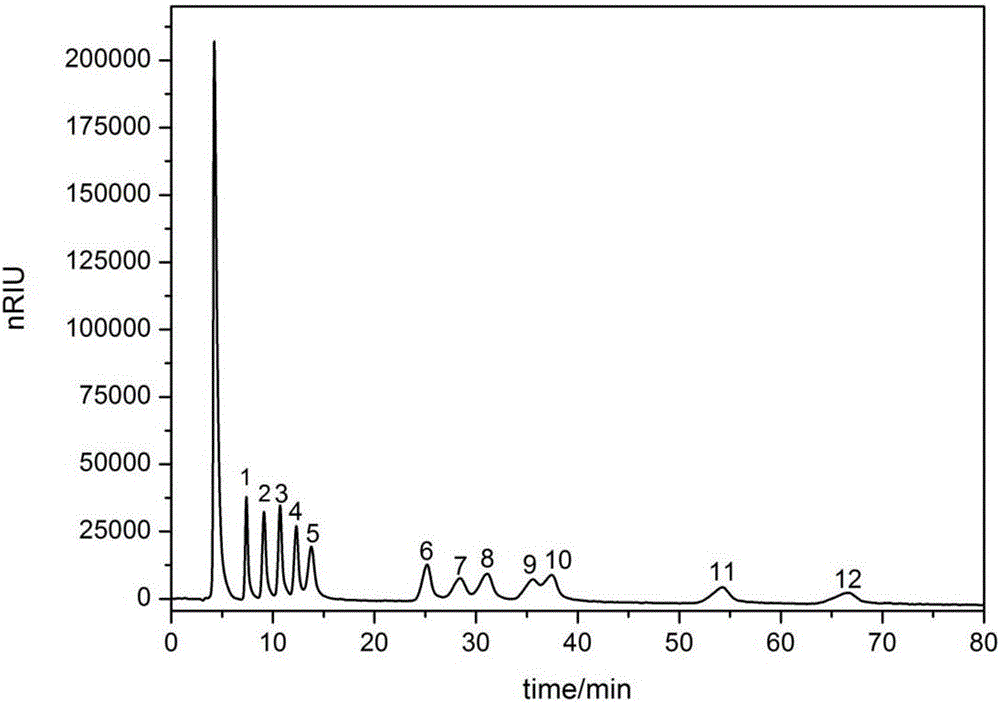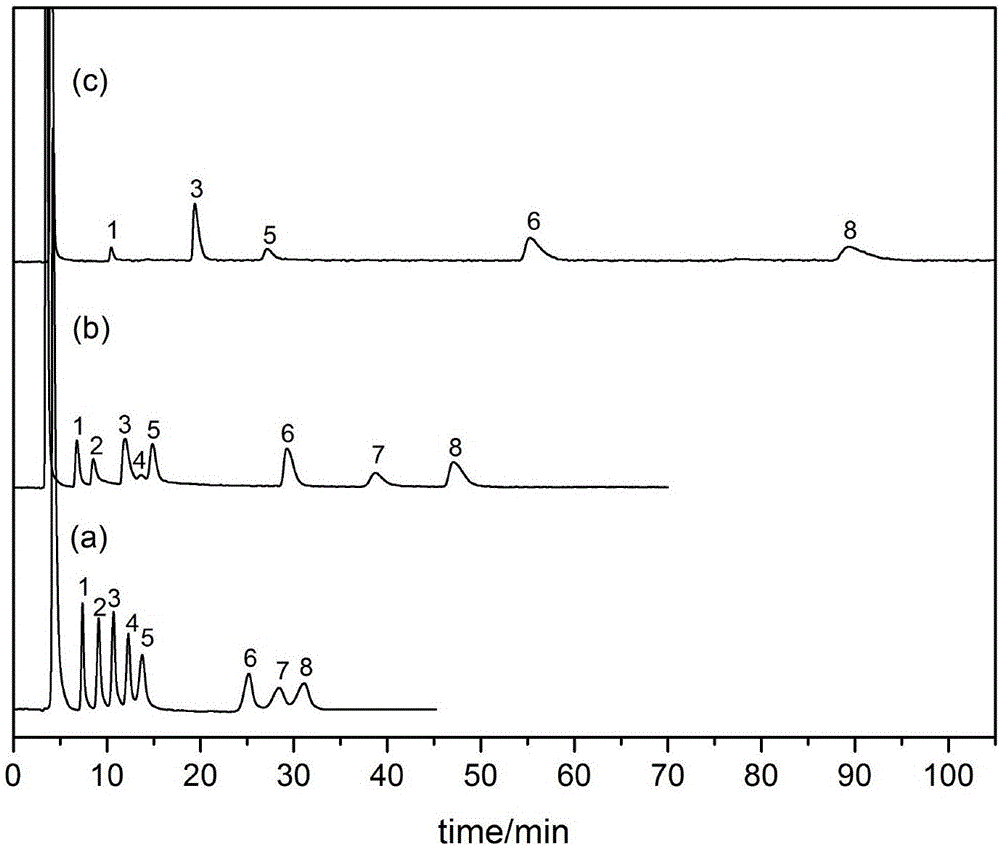Hydrophilic interaction chromatography/ ion exchange chromatography mixed stationary phase and preparation and application thereof
A technology of ion exchange chromatography and mixed stationary phase, which is applied in the direction of ion exchange, cation exchange, anion exchange, etc., can solve the problems of easy hydrolysis, short column life, easy oxidation, etc., and achieve strong separation ability, small column pressure and stable structure Effect
- Summary
- Abstract
- Description
- Claims
- Application Information
AI Technical Summary
Problems solved by technology
Method used
Image
Examples
Embodiment 1
[0036] Weigh 4.393g of silica gel and place it in a 100mL three-necked flask, add 40mL of anhydrous toluene, 6.418g of 3-chloropropyltrimethoxysilane, and 80 μL of triethylamine as a catalyst through a dropping funnel. Under the protection of argon, the reaction was refluxed for 24 hours. After the reaction was completed, it was filtered, the bonded silica gel was extracted with acetone for 24 hours, and 4.913 g of silanized silica gel was obtained after drying.
[0037] Weigh 4.127g of imidazole and 10.013g of anhydrous potassium carbonate in a 250mL three-neck flask, add 50mL of acetone with the dropping funnel, add 3-chloropropylamine hydrochloride dissolved in 50mL of acetone with the dropping funnel under stirring, then add 50mL of acetone , Under the protection of argon, the reaction was refluxed for 6hr. After the reaction is finished, filter, remove the acetone by rotating the filtrate with a water pump under reduced pressure, and then use an oil pump to distill the p...
Embodiment 2
[0044] The chromatographic column obtained above was used to separate monosaccharides, disaccharides and trisaccharides under the mode of hydrophilic interaction chromatography. High performance liquid chromatography differential refraction detection method was used, with acetonitrile / water (85 / 15, v / v) as the mobile phase, isocratic elution, the flow rate was 1.0 mL / min, and the detection temperature was 30°C. Chromatograms such as figure 2 As shown (1 is rhamnose, 2 is xylose, 3 is fructose, 4 is mannose, 5 is glucose, 6 is sucrose, 7 is maltose, 8 is lactose, 9 is trehalose, 10 is melibiose, 11 is raffinose, 12 is melezitose).
[0045] Depend on figure 2 It can be seen that the chromatographic column of the present invention can completely separate 12 kinds of carbohydrate compounds at one time, showing excellent separation ability.
Embodiment 3
[0047] Using the chromatographic column (a) prepared in the above examples, commercialized classic amino column (Fuji amino silica gel filler) (b), Waters high-efficiency carbohydrate analysis column (classic silica gel amino column) (c) in the hydrophilic interaction chromatography mode Separation of sugar compounds. High performance liquid chromatography differential refraction detection method was used, with acetonitrile / water (85 / 15, v / v) as the mobile phase, isocratic elution, the flow rate was 1.0 mL / min, and the detection temperature was 30°C. Chromatograms such as image 3 As shown (1 is rhamnose, 2 is xylose, 3 is fructose, 4 is mannose, 5 is glucose, 6 is sucrose, 7 is maltose, 8 is trehalose).
[0048] Depend on image 3 It can be seen that the chromatographic column of the present invention has a stronger retention capacity for sugar compounds than the other two classic amino columns.
PUM
 Login to View More
Login to View More Abstract
Description
Claims
Application Information
 Login to View More
Login to View More - R&D
- Intellectual Property
- Life Sciences
- Materials
- Tech Scout
- Unparalleled Data Quality
- Higher Quality Content
- 60% Fewer Hallucinations
Browse by: Latest US Patents, China's latest patents, Technical Efficacy Thesaurus, Application Domain, Technology Topic, Popular Technical Reports.
© 2025 PatSnap. All rights reserved.Legal|Privacy policy|Modern Slavery Act Transparency Statement|Sitemap|About US| Contact US: help@patsnap.com



